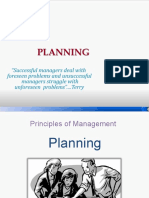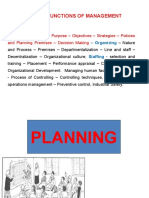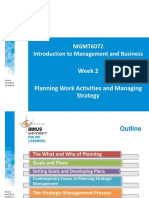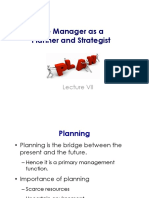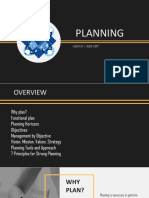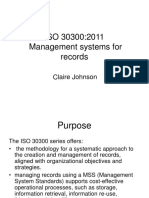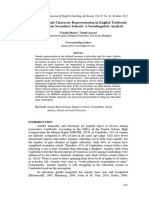MODULE – III
Planning
Prof. Mathew P
Department of
Mechanical Engineering
CET
1
� INTRODUCTION
Deciding in advance:
1. What is to be done?
2. When is to be done?
3. How is to be done?
4. Who is to do it?
It is an intellectual process of selecting missions and objectives and
putting down the actions to achieve them.
2
�• Predicting future is not possible. But plans may help us to attain a predicted
future.
• Controlling is possible only when there is a plan
• Planning is an analytical thought process that covers the following:
(a) Assessing the future
(b) Determining objectives and goals in the light of the future
(c) Developing alternative courses of action to achieve such objectives.
(d) Selecting the best course of action among the available alternatives.
• All other functions of the management, such as Organizing, Staffing, Co-
ordination, Directing, and Controlling follows the planning phase.
• Planning is basically a decision making process based on the predicted
future.
3
� THE NATURE OF PLANNING
1) Planning is the first function
• Among the functions of management, planning is the first function
• Without planning, all other functions of management become meaningless
• All other functions depend on planning function
2) Planning is a continuous process
• Planning is said to be a dynamic process
3) Planning has two components – objectives and techniques
• Selecting objectives
• Finding techniques to achieve them (such as policies, rules, etc)
4) Planning involves selecting from alternatives
• There are different alternative ways to attain any objective
• Planning involves selecting the best alternative
5) Planning is done at all levels
• The scope of planning differs based on the level of management
4
�6) Planning is an intellectual process
• A large number of factors are considered to arrive at the future course of action
7) Planning is essential to improve efficiency
• Planning is knowing things in advance
• Inefficiency due to unexpected turn of events can be avoided
8) Planning focuses on the future
• Based on predicted or estimated future
9) Planning involves flexibility
• In case of unexpected turn of events planning should be flexible
10) Planning not based on speculation
• Trial and error method or speculation may render the planning ineffective from the beginning
itself
5
� Importance of Planning
• Planning function is the basis for all other management functions
• Planning targets to achieve objectives, provides direction
• Anticipates crises and change, and makes organization ready to face them
• Reduces risks of uncertainty
• Promotes innovative ideas
• Planning is the reference for controlling function
• It coordinates all other activities
• It relates decisions to the objective (a guide to decision making)
• The actions of the management can be justified in the light of plans
• It can greatly improve all activities in an organization
6
�TYPES OF PLANS
Levels of
Planning
7
� Strategic Planning
• It’s big picture, long-term thinking. It starts at the highest level with
defining a mission and casting a vision.
• Strategic planning includes a high-level overview of the entire
business.
• It’s the foundational basis of the organization and will dictate long-
term decisions.
• The scope of strategic planning can be anywhere from the next two
years to the next 10 years.
• Important components of a strategic plan are vision, mission and
values.
8
� Tactical Planning
• “Tactical plans are about what is going to happen.”
• At the tactical level, there are many focused, specific, and short-term plans,
where the actual work is being done, that support the high-level strategic
plans.
• Tactical planning supports strategic planning. It includes tactics that the
organization plans to use to achieve what’s outlined in the strategic plan.
• Often, the scope is less than one year and breaks down the strategic plan
into actionable chunks.
• Tactical plans are concerned with the responsibility and functionality of
lower-level departments to fulfill their parts of the strategic plan.
• Tactical planning is different from operational planning in that tactical plans
ask specific questions about what needs to happen to accomplish a
strategic goal; operational plans ask how the organization will generally do
something to accomplish the company’s mission.
9
� Operational Planning
• They are the plans that are made by frontline, or low-level managers
• All operational plans are focused on the specific procedures and
processes that occur within the lowest levels of the organization.
• Managers must plan the routine tasks of the department using a high
level of detail.
• Preparing budgets is an example of operation planning
• Strategic and tactical plans are finally converted into operational
plans
10
� Contingency Planning
• Contingency plans are made when something unexpected happens or
when something needs to be changed.
• Business experts sometimes refer to these plans as a special type of
planning.
• Contingency planning can be helpful in circumstances that call for a
change.
• Although managers should anticipate changes when engaged in any of
the primary types of planning, contingency planning is essential in
moments when changes can’t be foreseen.
• As the business world becomes more complicated, contingency
planning becomes more important to engage in and understand.
11
�Hierarchy of Plans
12
� STEPS IN PALNNING
Getting to know Finding
about the alternative
opportunities courses Developing
supporting
plans
Comparing
Setting
alternative Sequencing of
objectives
courses plans and
preparing
budgets
Developing Selecting the
planning best course of
premises action
13
� OBJECTIVES
"Objectives are the goals, aims or purposes that organization wish to
achieve over varying period of time.“ - Dalton E. McFarland
• The planned or anticipated end results of an organization are called
Objectives.
• Objectives may be
1. Long term objectives
2. Short term objectives
3. Broad objectives
4. Specific objectives
5. Economic objectives
6. Social objectives
7. Human objectives
14
� Nature of Objectives
1. Hierarchy of objectives
2. Multiplicity of objectives
3. Periodicity of objectives
4. Qualitative and Quantitative objectives
5. Measurability of objectives
6. Flexibility of objectives
7. Network of objectives
15
�1. Hierarchy of objectives
• Hierarchy means the relative importance of objectives.
• The most important objective is written first, and the least important objective is written last.
• All objectives are important. However, some objectives are more important than others.
• Some objectives need immediate action while others can be kept aside for some time.
2. Multiplicity of objectives
• A business does not have only one objective at a time. It has many or multiple objectives.
• This is because a business has to satisfy different groups, i.e. shareholders, employees, customers,
creditors, vendors, society, etc.
• The business has to fix different objectives for each group.
3. Periodicity of objectives
• Based on period, business objectives can be classified into two types; Short-term objectives, and
Long-term objectives.
• The short-term objectives are made for a short-period, i.e. maximum one year. Short-term
objectives are more specific.
• The long-term objectives are made for a long-period, i.e. for five years or more. Long-term
objectives are more general. They are like a Master Plan.
16
�4. Qualitative and Quantitative objectives
• Quantitative objectives are easy to measure. It is expressed in numbers. For e.g. in Dollars,
Rupees, Percentage, etc. Quantitative objectives are visible, tangible and countable.
• Qualitative objectives are not easy to measure. It is not expressed in numbers. For e.g. Employee
performance, employee satisfaction, etc. These objectives cannot be measured. Qualitative
objectives are invisible, intangible and uncountable.
• Today modern methods are used to measure qualitative objectives. A business must have both
quantitative and qualitative objectives.
5. Measurability of objectives
• The objectives must be clear and specific. It must be easy to measure. For e.g. Each salesman
must sell 100 units of water purifier per month. This is a clear and specific objective.
• Measurable objectives motivate the employees to work hard. This is because they know their
target clearly. Their performance can also be measured easily.
17
�6. Flexibility of objectives
• The business objectives must also be flexible, since the environment is continuously changing.
• There are continuous changes in the technical, social, economic and political environment.
• The business has to change its objectives according to the changes in the business environment.
7. Network of objectives
• Network means an interconnection between different objectives.
• A business has many different objectives, viz., corporate objectives, departmental
objectives, sectional objectives and individual objectives. It also has objectives for
shareholders, customers, employees, etc.
• All these objectives must be interconnected. They must support each other. They must
not clash with each other. They must move in the same direction.
• If not, the business will not survive. Similarly, the objectives of all the departments, must
support each other. They must not clash or conflict will each other.
18
�Characteristics of good objectives
19
�• Specific:- Clearly defined so that everyone has the same idea
of what is to be achieved.
• Measurable:- It is required to have an idea of how must is
achieved.
• Achievable:- Unachievable objectives demotivates
employees, does not contribute towards the goal of the
organization.
• Relevant:- Should help to achieve the organization goal.
• Time bound:- Objectives should be attained within a time
scale.
20
� Management By Objectives (MBO)
• Stresses on achievement of results expressed in terms of objectives.
• Also called performance oriented appraisal. Bot employer and
employee are interested in the performance of the employee.
• Performance appraisal helps to identify the reasons for under-
performance.
• “MBO is a complete managerial system that brings together
important managerial activities in an organized manner with the
purpose of directing them for achieving both organizational and
individual objectives in an effective and efficient manner.”
21
� Characteristics of MBO
• Main focus is on performance appraisal
• Emphasis is on what is to be done and not how things are to be done
• Serves as a motivational technique
• Inculcates a self control and self direction culture
• Integrates long and short range objectives
• Promotes participation of subordinates in setting objectives
• Reviews provide information for planning and to initiate corrective action
• Improves organization’s capacity
• Emphasizes on effective performance
• Everyone’s performance is evaluated
22
�MBO Process
23
� Advantages of MBO
• Improved management
• Clearly defined roles and structures
• Encourages people to commit themselves
• Aids in developing effective controls
• Subordinate gets a chance to involve in his own performance appraisal
• MBO emphasis is on performance
• Promotes understanding between superior and subordinates
• Helps in identifying talent and training needs
• Better coordination among departments
24
� Limitations of MBO
• Superiors do not clearly explain the process of MBO to subordinates
• Clear guidelines for goal setting not available in MBO
• Difficulty in setting goals that meet all the criteria
• Too much focus on short term objectives
• Superiors may oppose to change the objectives of subordinates
• MBO process is time consuming
• More administrative work is involved in MBO
• Success of MBO depends on active participation of both superior and
subordinate
• Requires high level commitment from top management
25







